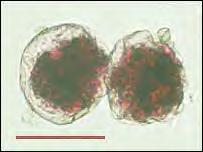
[scale: the bar = 50 microns, or 50 millionths of a meter]
The more we learn about life, the more amazing it seems. Life is much more tenacious than we once imagined and we keep discovering it in places that not so long ago we thought it couldn't exist.
Tiny single-celled creatures, many of them previously unknown to science, have been found at the deepest point in the world's oceans, almost 11km[, nearly seven miles,] down.The Japanese team which made the discovery noted that these single-cell creatures belong to the lineage with has provided "the only species to have invaded fresh water and land" - that is, this is kin to where we came from.
The soft-walled foraminifera, a form of plankton, were recovered by the Japanese remote submersible Kaiko. ...
[T]he organisms have become adapted to the crushing pressures that exist in a location of the Marianas Trench known as Challenger Deep.
This hole in the ocean floor is totally dark and the immense column of water above pushes down with a force that is over a thousand times greater than that at the surface - about 110,000 kilopascals.
Foraminifera are thought to be the most abundant form of life in the seas after bacteria.
They typically have shells, but these organisms are soft because there is insufficient calcium carbonate at such depth to build hard parts.
Kaiko was lost on a mission to the Nankai Trough in 2003. There is currently no remotely operated vehicle in service that can reach the bottom of the Marianas Trench.Whenever I hear or read about someone worrying that science is taking the wonder out of existence, making everything into cold calculation, I think of things like this and I say again, as I have before, "keep your gods: The universe is wonder enough for me."





No comments:
Post a Comment